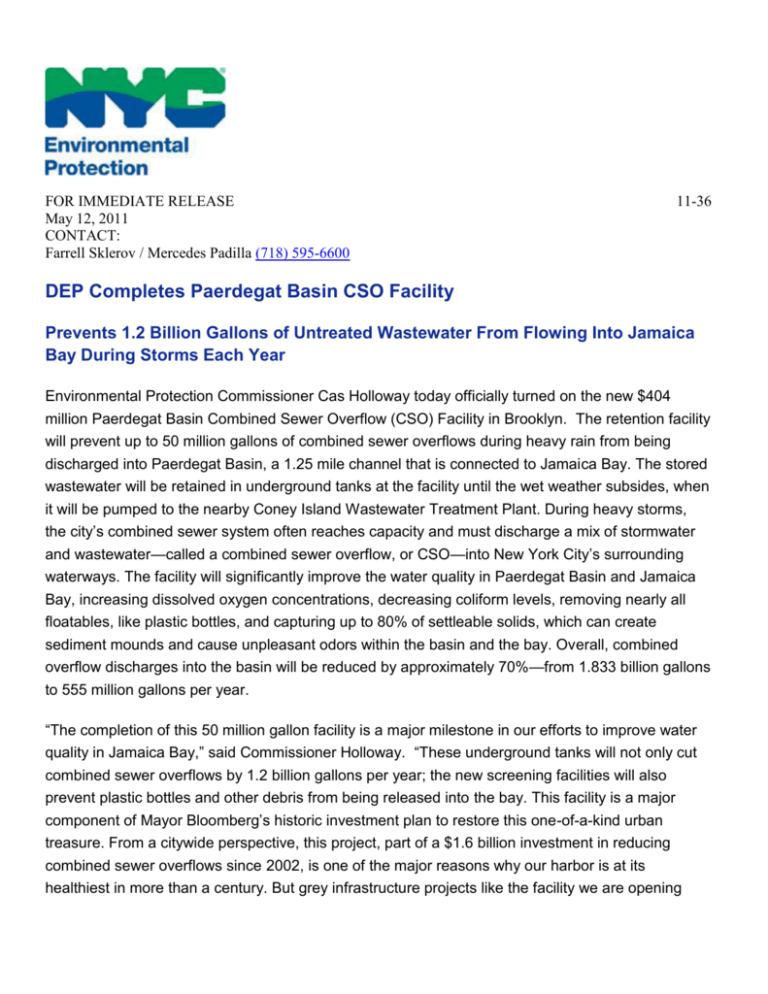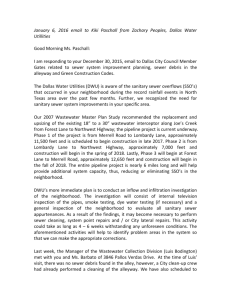DEP Completes Paerdegat Basin CSO Facility
advertisement

FOR IMMEDIATE RELEASE May 12, 2011 CONTACT: Farrell Sklerov / Mercedes Padilla (718) 595-6600 11-36 DEP Completes Paerdegat Basin CSO Facility Prevents 1.2 Billion Gallons of Untreated Wastewater From Flowing Into Jamaica Bay During Storms Each Year Environmental Protection Commissioner Cas Holloway today officially turned on the new $404 million Paerdegat Basin Combined Sewer Overflow (CSO) Facility in Brooklyn. The retention facility will prevent up to 50 million gallons of combined sewer overflows during heavy rain from being discharged into Paerdegat Basin, a 1.25 mile channel that is connected to Jamaica Bay. The stored wastewater will be retained in underground tanks at the facility until the wet weather subsides, when it will be pumped to the nearby Coney Island Wastewater Treatment Plant. During heavy storms, the city’s combined sewer system often reaches capacity and must discharge a mix of stormwater and wastewater—called a combined sewer overflow, or CSO—into New York City’s surrounding waterways. The facility will significantly improve the water quality in Paerdegat Basin and Jamaica Bay, increasing dissolved oxygen concentrations, decreasing coliform levels, removing nearly all floatables, like plastic bottles, and capturing up to 80% of settleable solids, which can create sediment mounds and cause unpleasant odors within the basin and the bay. Overall, combined overflow discharges into the basin will be reduced by approximately 70%—from 1.833 billion gallons to 555 million gallons per year. “The completion of this 50 million gallon facility is a major milestone in our efforts to improve water quality in Jamaica Bay,” said Commissioner Holloway. “These underground tanks will not only cut combined sewer overflows by 1.2 billion gallons per year; the new screening facilities will also prevent plastic bottles and other debris from being released into the bay. This facility is a major component of Mayor Bloomberg’s historic investment plan to restore this one-of-a-kind urban treasure. From a citywide perspective, this project, part of a $1.6 billion investment in reducing combined sewer overflows since 2002, is one of the major reasons why our harbor is at its healthiest in more than a century. But grey infrastructure projects like the facility we are opening today are only part of the solution. Our NYC Green Infrastructure Plan, which relies on green elements to absorb and retain stormwater before it ever enters the sewer system, is the next major step that we need to take. Green infrastructure is more sustainable, more affordable and, over the long term, more effective than traditional grey solutions, and we are moving aggressively to implement the plan in communities throughout the five boroughs.” “This is a big step forward for Jamaica Bay, a true place of refuge for birds, wildlife, and New Yorkers alike,” said Lawrence Levine, Senior Attorney at the Natural Resources Defense Council. “By making upgrades like this to the city’s aging sewer system and investing in green infrastructure in our communities - such as parks, green roofs, porous pavement and roadside plantings - we can curb sewage overflows citywide. These smarter practices on land will prevent water pollution from the start and make New York City a better, greener place to live.” “The Jamaica Bay Eco Watchers commends Commissioner Holloway and the New York City Department of Environmental Protection for the completion of the Paerdegat Basin Combined Sewer Overflow (CSO) facility in Brooklyn,” said Jamaica Bay Ecowatchers President Dan Mundy Sr. “The retention tanks holding 30 million gallons plus another 20 million gallons in the connecting lines will prevent not only the discharge of 50 million gallons of waste water into Jamaica Bay during rain events but will also screen out debris and floatables from entering the waterway. This plus the recent NYC Green Infrastructure Plan initiated by Mayor Bloomberg will significantly improve water quality by capturing and retaining storm water runoff from entering the sewer system. This is a huge step in returning Jamaica Bay to a wetland and estuarine area of national importance.” “Each year combined sewer overflows result in warnings not to use our local waterways for recreation and shellfish harvesting due to high bacteria counts,” said Debbie Mans, Executive Director, NY/NJ Baykeeper. “We commend New York City for investing in the protection of public health and the environment by taking these steps to prevent combined sewer overflows from entering our shared waters.” The Paerdegat Basin CSO Facility consists of four retention tanks that can hold 30 million gallons of sewer overflows, and another 20 million gallons can be stored in the connecting sewers. The facility also includes a screening apparatus that will screen the flow prior to entering the storage tank to remove large size debris and floatables, like plastic bottles and other trash that enters the sewer system; the collected debris will be sent to storage containers and then transported out of the plant for disposal. To mitigate any odors from the plant, DEP built an odor control system and all process areas will be ventilated and receive odor control treatment. The odor control system includes five exhaust air trains with the latest advances of technology and also carbon filters and variable speed fans. Within the facility, a pumping station helps send the retained wastewater back to the Coney Island Wastewater Treatment Plant after the rain subsides. Located in Sheepshead Bay, Brooklyn, the Coney Island plant the plant provides treatment for 110 million gallons of wastewater at average conditions, but it has a capacity to treat 220 million gallons of wastewater for the 685,000 New Yorkers it serves. The Paerdegat Basin Facility is the largest of four combined sewer overflow retention tanks built in New York City, including the Flushing Bay and Spring Creek Combined Sewer Overflow retention facilities now in operation. Spring Creek went online in1972 and can hold up to 20 million gallons of wastewater. Flushing Bay CSO facility went online in 2007 and can hold up to 43 million gallons of wastewater. Alley Creek CSO facility will be in operation at the end of this month and will hold five million gallons of wastewater. Since 2002, DEP has spent approximately $1.6billion to upgrade wastewater treatment plants and to reduce combined sewer overflows. Two-thirds of New York City has a combined sewer system that collects wastewater and stormwater runoff together in the same pipe from properties and streets. This often presents an issue during rainstorms when treatment plants can reach their capacity. To relieve the sewage system during these high-flow periods, the interceptor sewers have “regulators” equipped with overflows weirs that divert combined stormwater and wastewater into New York City’s surrounding waterways. Upgrades to our plants and sewers have allowed us to capture a greater amount of overall flow, from about 30% in the 1980s to over 72% today, and overflows are more dilute, with the percentage of sanitary waste decreasing from 30% to about 12% today. To address this challenge long term, last September, Mayor Bloomberg unveiled the NYC Green Infrastructure Plan, which will improve harbor water quality by capturing and retaining stormwater runoff before it enters the sewer system. The plan, which includes $2.4 billion in green infrastructure, will reduce sewer overflows by 40% by 2030. This approach will also save $2.4 billion over the next 20 years because it will reduce more costly investments in traditional sewage retention projects, like tanks and tunnels. Green infrastructure uses vegetation, soils, and other structural elements to absorb and evaporate water and to mimic natural areas and hydrologic cycles. These types of projects are a key component of PlaNYC’s sustainability effort because they also shade and cool the city, improve air quality, and increase property values. Improving New York City’s harbor waters through cost-effective grey infrastructure and beneficial green infrastructure are outlined in Strategy 2011-2014, a far-reaching strategic plan that lays out 100 distinct initiatives to make DEP the safest, most efficient, cost-effective, and transparent water utility in the nation. The new plan, the product of nearly one year of analysis and outreach, builds on PlaNYC, Mayor Bloomberg’s sustainability blueprint for New York City. The plan is available on DEP’s website at www.nyc.gov/dep. DEP manages the city’s water supply, providing more than 1 billion gallons of water each day to more than 9 million residents, including 8 million in New York City. New York City’s water is delivered from a watershed that extends more than 125 miles from the city, and comprises 19 reservoirs, and three controlled lakes. Approximately 7,000 miles of water mains, tunnels and aqueducts bring water to homes and businesses throughout the five boroughs, and 7,400 miles of sewer lines take wastewater to 14 in-city treatment plants. For more information, visit www.nyc.gov/dep or follow us on Facebook at www.facebook.com/nycwater. Learn more at the NYC Environmental Protection website. This is the NYC.gov news you requested for: All DEP Press Releases To unsubscribe please go to this link: https://www.nyc.gov/portal/signin.jsp




